It was a fine spring day in Southern California when we started getting alarms from Mazourka Peak. The alarms indicated that the voltage was low on our battery system that powers our radio site equipment. There is no shoreline power from Edison or DWP, the two electrical service providers in the area. Therefore, everything at the site runs off of solar power that charges batteries.
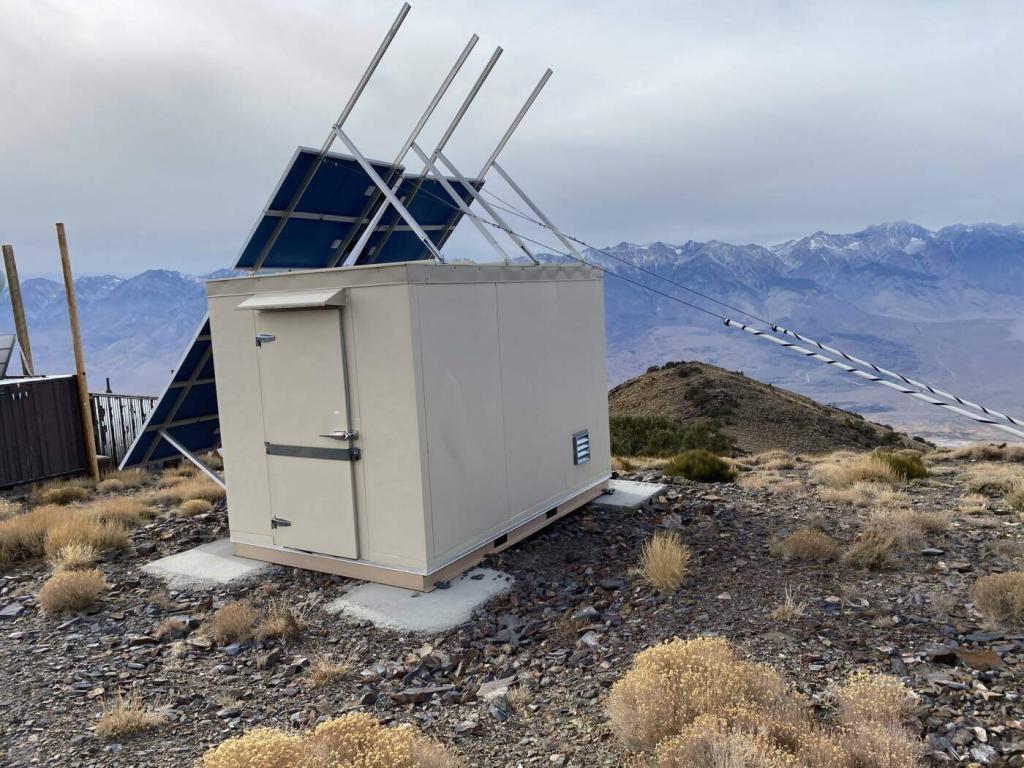
Our equipment is powered by two 400 watt solar panels which charge a large bank of batteries. The battery bank consists of 38 batteries that are over 100 amp hours each, thus making the battery bank over 3800 amp hours. This is large enough to power the equipment for about 30 days without any sun or charging from the solar system.
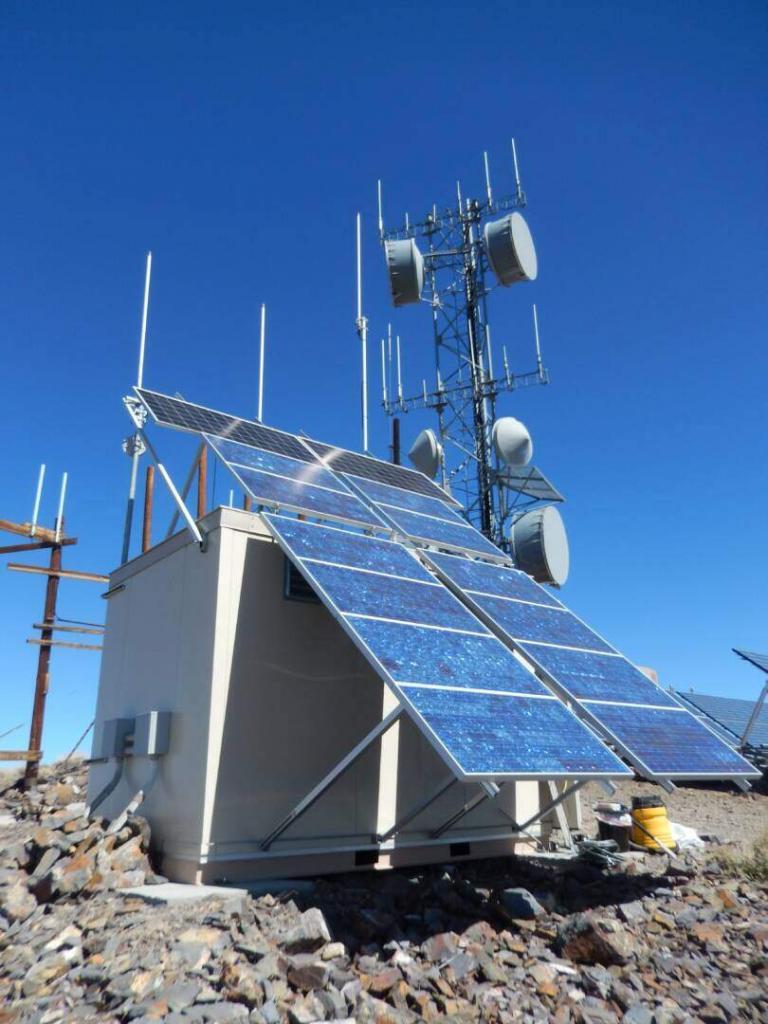
I left the house at a time that we commonly refer to as zero dark thirty. In general, it means that we are leaving our house very early before the sun is up because we are heading to a mountain top to do some work and we want to go get done with the work and get down off the mountain before it gets dark. This site is about 6 hours of driving to get to the top of the mountain, so leaving early was necessary. It was 5:45AM when I left the house and proceeded to head north on Crenshaw Blvd for 20 minutes to get to the San Diego Freeway (Interstate 405) to head north. The freeway was already busy when I reached it at 6:05AM, but it was traveling at mostly full speed at least until I reached the LA Airport area where it slowed down temporarily and then again when I approached the Culver City area. Traffic remained slow until reaching the Santa Monica Freeway (Interstate 10) at which point the traffic began to break up and return to full speed. I proceeded to head north through Westwood until reaching the Sylmar area where it slowed down again until I reached the Antelope Valley Freeway (Highway 14) where traffic opened up to full speed.
The trip was relatively uneventful as I proceeded north on Hwy 14. I passed through the mountains as the freeway dropped down into the Palmdale area. Continuing north on the highway, I passed Avenue A where one would turn off to head towards Edwards Space Force Base if so inclined. However, I was not planning to stop there, so I continued north to Mojave where I made a pit stop to use the facilities and get something to drink during the long trip. I decided that it was time for some caffeine to help keep me awake. I had set the alarm for 4:30AM and had gotten to bed around 11:30PM the night prior, so I was running near empty from a sleep standpoint and felt that the caffeine jolt would be beneficial.
Leaving Mojave around 8:00AM, I proceeded north on Highway 14 past Jawbone Canyon, through Red Rock Canyon, past Robin’s Roost and eventually merging with US395. Continuing north past Pearsonville, Coso Junction, Olancha, Cartago and continuing north until reaching Lone Pine. The town was bustling with the normal morning activity as I passed through to continue my journey north to Independence where I stopped at the Sheriff’s Office to let them know that I was heading up the mountain to the radio site and picked up the key to the site. The dispatcher informed me that she had driven up the mountain a few days earlier and found that most of the road was in very bad shape thus requiring a significant amount of extra time to get up to the radio site on the mountain. I thanked them for the information and proceeded to head north to the Piute Gas Station to fill up with gas and to get some additional liquid supplies so that I did not get caught on the mountain without sufficient drink. I did not get anything to eat as these days, my innards are particularly sensitive and I did not want to suffer from any urgent need for a restroom when none were available. After finishing at the station, I headed south about 2 miles back to the Sheriff’s station turning east on Mazourka Canyon Road. From that point, it is normally about 60 minutes travel with a distance of 20 miles. The first 4.5 miles are paved road, then it changes to a semi paved road and then to an improved dirt road. However, with the news that the road is in bad shape, I was not sure what I would encounter on the way to the site. I proceeded approximately 4.5 miles until the pavements ends where I encountered a Department of Water & Power (DWP) work crew who were blocking the road. They were replacing an underground drainage pipe that allowed water to pass under the road unobstructed. In speaking with the supervisor, they expected to have the road blocked until 3PM. I looked at the work that they were performing and it was clear that I was not going to get past their equipment because about 6 feet of the road was missing. Without wings on my vehicle, I was not going to get to the other side until they finished their work. So, I turned around and headed west back to the highway.
As I was heading west, I was contemplating my options and decided that I could take care of some other business while the road was blocked. I would head north to Bishop which was a 45-minute drive and visit City Hall to talk to them about the requirements for the antennas that we wanted to install for another tower site in the downtown area so that we could provide better radio coverage in town. So, I turned north and drove to the building that we were going to use so that I could get the street address before heading to City Hall. Unfortunately, the address was not on the building, so I had to park the SUV and head inside to find out the address which took about 10 minutes. I then headed south to City Hall armed with the correct address for any paperwork that would need to be completed. I parked the vehicle and proceeded to head inside not knowing which office would handle my situation. After bouncing around two offices, I was directed to the correct office. Unfortunately, the inspectors were out of the office and the secretary did not know the answers to my questions about the City requirements. She wrote a note and said that she would call me later in the day.
The next stop was over by the Bishop Airport to see Eastern Sierra Transit. We had given them a demo last year where they tested our radio system and found it worked as represented. However, they have some requirements that we did not meet so I felt that I should inform them as to our progress in meeting those requirements. They were pleased to hear about our progress, so it was now time to head over to Optimum regarding the internet service for my place in Mammoth. They had no one in line at the office, but it still took her about 30 minutes to get all the paperwork handled. Now it was time to head back south to Independence and up to the mountaintop site.
I arrived at the location of the DWP work crew in the afternoon around 3PM to find that the work was finished and the road was now passable. I proceeded up the road which seemed to be normal and as it had been in the past. For several miles, the road continued to be the same as before as I worked my way up the canyon. Unfortunately, the normal road did not last as I started to find large sections of the road to be completely missing. Since the road primarily traveled the bottom of the canyon, the water would drain down the mountain while traveling on the surface of the compacted dirt road allowing the massive volume of water to remove up to two feet of the road surface. If it had done this uniformly along the entire road, it would have been easier to travel. However, there were areas that were virtually untouched by the water and then drop 2 feet down to a dry riverbed that had mainly rocks and very little dirt. There were mounds of rocks making waves of mounds, moguls and other irregular surfaces which made travel slow and difficult. There were times that I was driving at two miles per hour and I was convinced that I was going two miles per hour too fast. Sometimes I had to stop and contemplate the least difficult path to travel to avoid taking out a tire or the vehicle axle. There were many times that I heard crashes underneath the vehicle indicating that some rocks had found their way to contact the undercarriage of the 4WD SUV that I was driving. The ground clearance of the vehicle was constantly being tested and did not always pass the test, but I continued to forge ahead in spite of the difficulties of the road. There is a famous line out of the movie Apollo 13, “Failure is not an option!” I take that saying seriously when I travel to the over 70 mountain top tower sites where we have equipment.
I continued to slam, crash and bang my way on what was left of the road that went up the mountain that I was climbing. Eventually, I arrived at the Badger Flat area where I was ready to rejoice because from here on out I felt that I would not have a difficult time with the road. That was mostly true, but there were a few short sections of the road that had issues that were a cause for concern such as mud puddles and areas of dense clay that was soaked causing deep holes in the road that could get the vehicle stuck. I managed to get past these areas by driving off the formal roadbed into the brush which had a different set of issues. However, I managed to get past all of these obstacles and eventually arrived at the top of the mountain around 4:30PM. Considering how bad the road condition was at this time, I felt that it would be best for me to leave by 6PM so that I could get off the mountain by 8PM before it got dark on the mountain which would make the driving down the mountain far more treacherous.
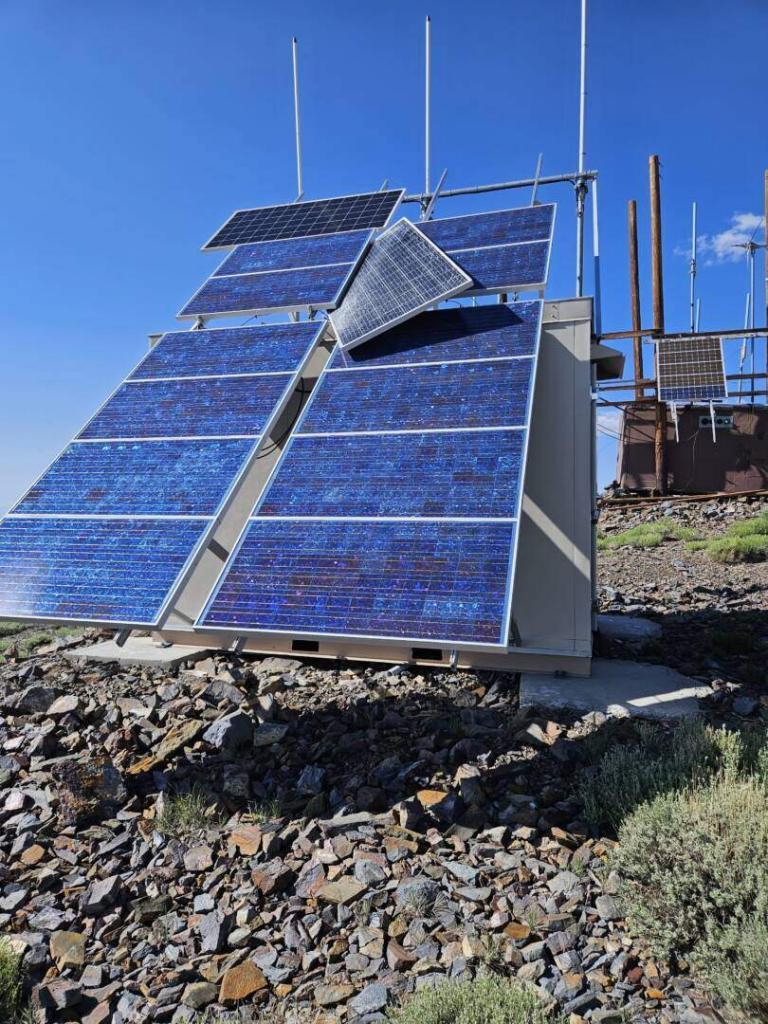
I pulled the SUV up in front of the building and the problem with the power system appeared to be obvious. One of the solar panels had broken loose and was hanging by the wires. In addition, the panel was bent and the front glass was cracked. It was clear that I would be unable to fix the solar panel as I did not have another one with me, nor did I have a ladder tall enough to reach the solar panel on top of the building. I checked around the building and found that part of the solar panel was hidden from the sunlight, so assuming that it was functional, it would not get any sun from which to generate electrical power. I got out of the SUV and walked around the building to assess the damage while taking some pictures with my phone. I returned to the car to grab my camera so that I could take more pictures. After some time, I decided that it was time to open the building and check out the battery system and see what the condition was of the battery system inside the building.
Upon entering the building, I scanned the battery system to see if anything looked awry. I then looked at the radio equipment to see if everything looked normal. I then scanned the battery bank for Inyo County. I returned to the car to get my VOM so that I could take voltage readings. I proceeded to take multiple readings on the two different battery banks. It was clear that the Inyo County battery system was in a world of hurt and the battery system for the MRA repeaters seemed to be OK except for the lack of charge on the batteries as a result of the solar panel being damaged. Now it was the time to get out the generator that I had in the car along with the battery charger so that I could place the batteries on charge.
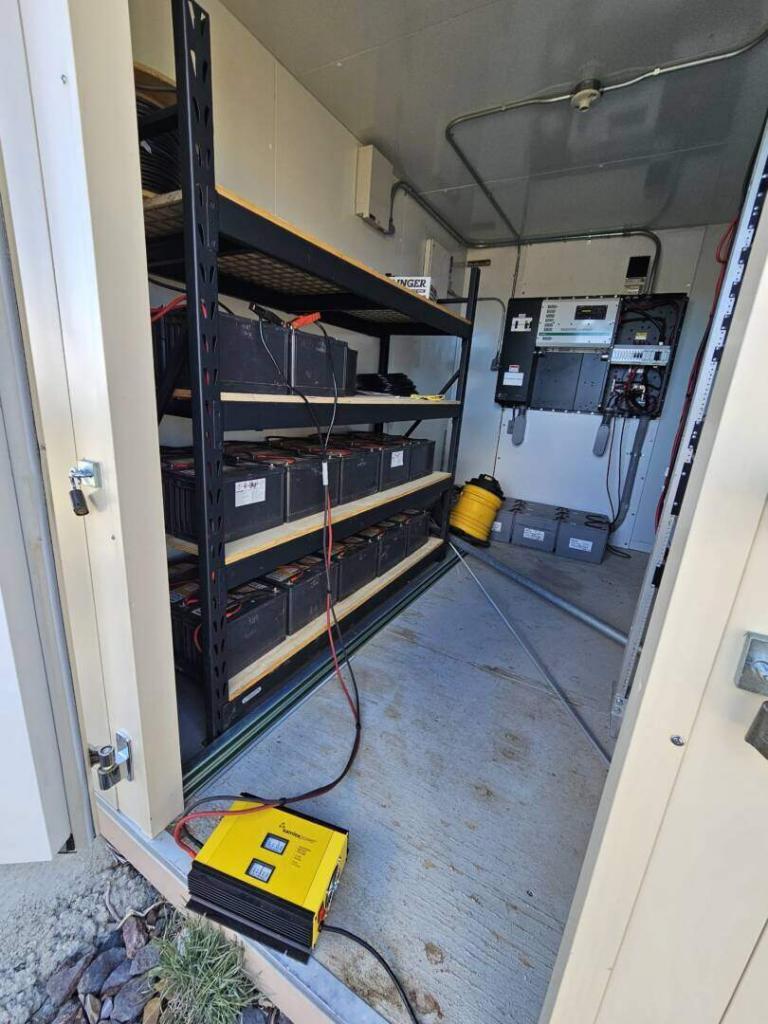
Returning to the SUV, I opened the back passenger side door to remove the Honda generator. It is not too heavy and is easily handled compared to most generators, but it only has a capacity of 2KW. However, the battery charger only would use a maximum of 1KW to charge the batteries, so the small generator was perfect for the job. I pulled it out and set it up near the door to the building. I turned on the switch, threw the choke and pulled the rip cord to start the generator. It fired up on the first pull most likely because we had fired it up the day before and ran it for about 10 minutes. I then grabbed the battery charger and plugged it into the generator. I grabbed the charger leads and plugged them into the charger and attached them to the battery bank. Now the batteries were being charged by my temporary equipment while also being charged by what was left of the solar power charging system. This helped to build up the charge on the batteries to compensate for the lack of charging from the solar panels. I had another battery testing device that could place a load on the battery to check for voltage drop under load. I hooked it up to the battery system so that I could read the voltage of the batteries while they were being charged. I did not think that it would be required to apply the load to the batteries as they were suffering from a lack of being charged in the first place so adding a load to drain the batteries seemed to be counterproductive. I then compared the reading on the load tester to the voltage reading on the solar charge controller and to my VOM to be certain that the reading were consistent from one device to another device.
It was time to get out my toolbox and grab some tools to tighten up the connections on the batteries. I started doing it with a crescent wrench, but it was slow and awkward to use the wrench so I returned to the toolbox to get out my 7/16” box wrench which would handle the job with far greater efficiency. I methodically torqued each bolt until it was properly tight. I found several bolts that had loosened up over time (or had never been tightened properly in the first place) which required the proper torque to tighten the bolt so that a loose connection would not take down the system. After finishing the tightening of all of the bolts, I put the tools away.
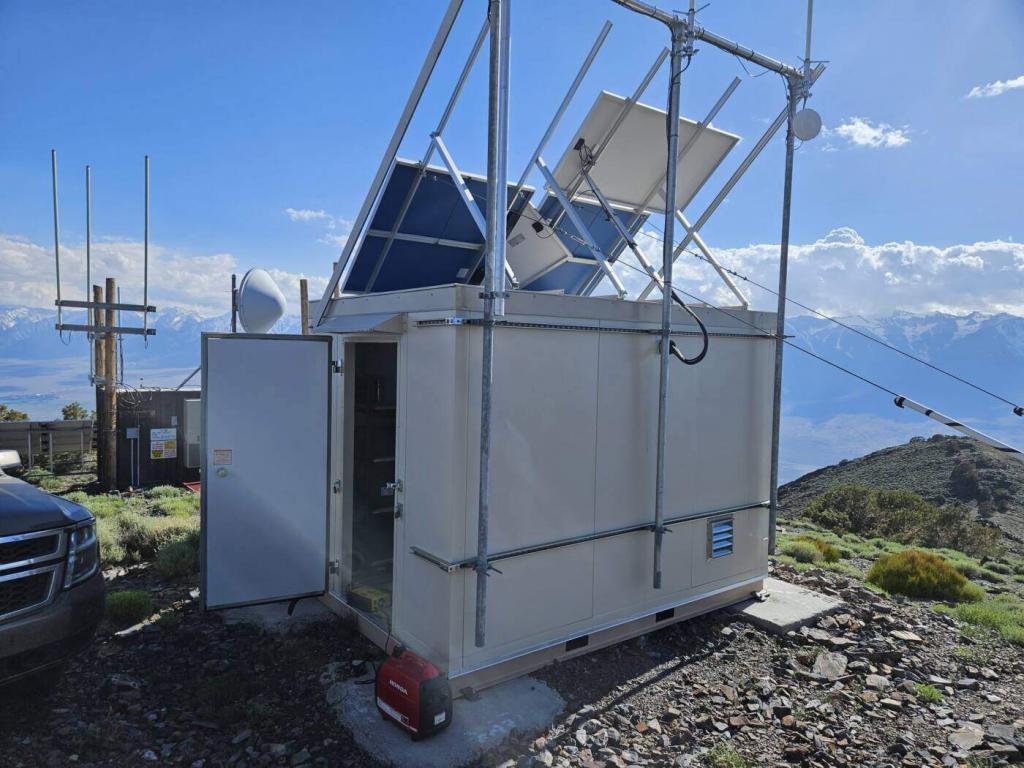
Now was time to take more pictures for the files. I walked around the building taking pictures from various angles so that the guys in the shop could properly evaluate what they would need to bring to the site to repair the solar array. Other pictures were taken to document the condition of the building, the equipment and the site in general. It was now approaching 6PM the time that I had set in my mind as the time that I needed to leave the site. However, I felt that I needed to give the batteries more of a charge which meant that I needed to hang out at the top of the mountain. I thought that I could stay until 6:30PM which would get me down by 8PM while there still was a reasonable amount of light available from the sun. Now that we are approaching the summer Solstice, the days had gotten to be long and it seemed like I would be OK until at least 8:30PM, so I sat down in the car and turned on the broadcast radio to listen to some music while I waited another half an hour for the batteries to get more of a charge. I sat in the car listening to music for about 15 minutes. I then opened the car door and proceeded to put away everything that I could except for the generator and the battery charger. I then sat down in the car waiting for 6:30PM so that I could pack up the last of the equipment. The time to leave finally arrived and I shut down the generator. I had to close the vent on the gas tank in the generator and I had to close the fill on the gas can to prevent the gas from leaking out into the car and contaminating the air inside the vehicle. I then grabbed the battery charger, rolled up the cables and placed it back into the SUV and then lock up the building. So after 5-7 minutes, I was ready to leave but it was clear to me that we would have to return to the site fairly soon with new solar panels to get the solar system functioning normally. The charging of the batteries with the generator was only a temporary measure to get us by for at most a few days.
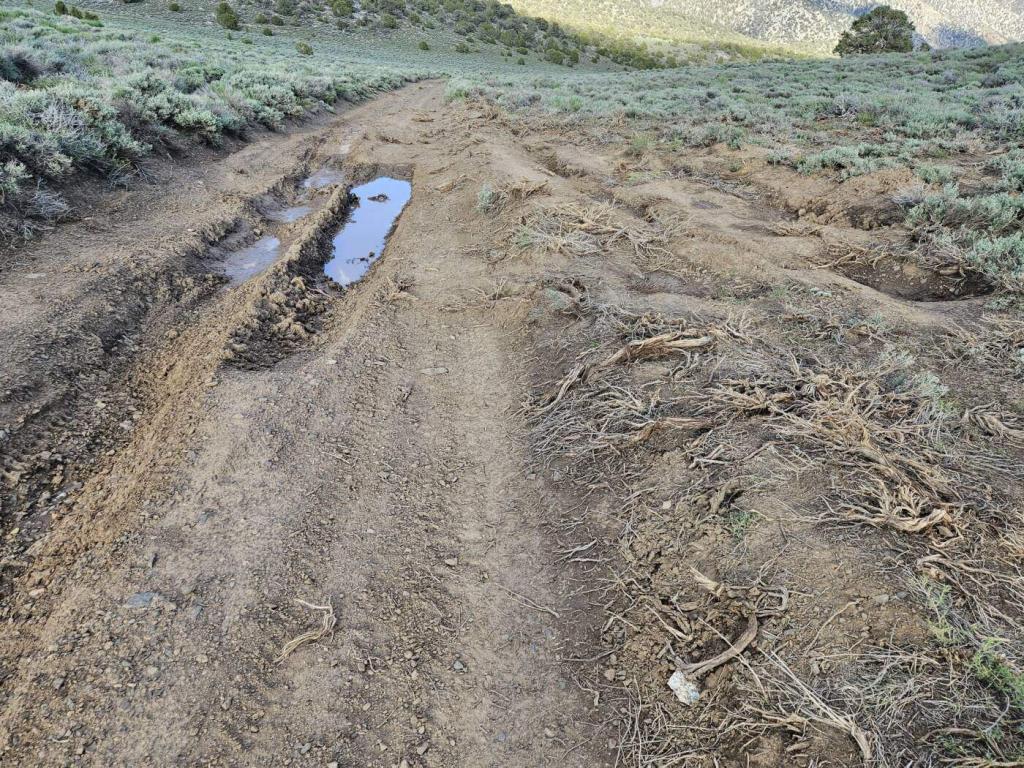
I started backing out to where I could turn around and then proceeded to head down the mountain. The road conditions were decent at this point of the road, so I started traveling at a fairly good clip of speed. I wanted to document the road conditions so I would stop periodically to take pictures in areas of the road that were of some concern once I got down to the Badger Flat area. After making numerous stops and taking lots of pictures, I started to head down the road again at which point I got the idea to take a video of my drive down the mountain. Another one of our people had come up with the idea of jamming the phone between the top of the passenger seat and the headrest which took video looking out of the windshield through the dirty glass that was filled with smashed bugs, dirt and other maladies. So I set up my new cell phone and got it recording through the windshield. I walked around the car and got back into the vehicle so that I could continue down the road with the camera watching my progress as I headed down the mountain. Eventually, I reached the portion of the road that had been compromised by the rains and had to slow down to a crawl to keep from wiping out the SUV.
Up to 2 feet of the roadbed is missing
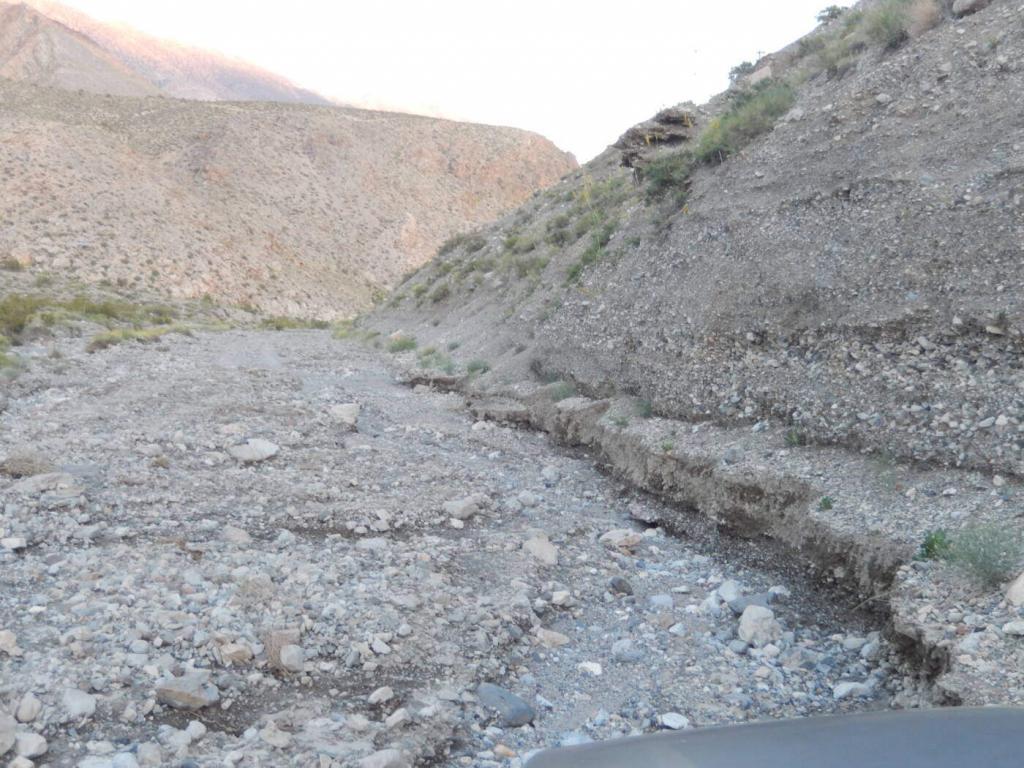
As I continued heading down the hill, the road repeated its challenges but this time after the long day and beginning to get tired, I felt that I would be less tolerant of the shake,
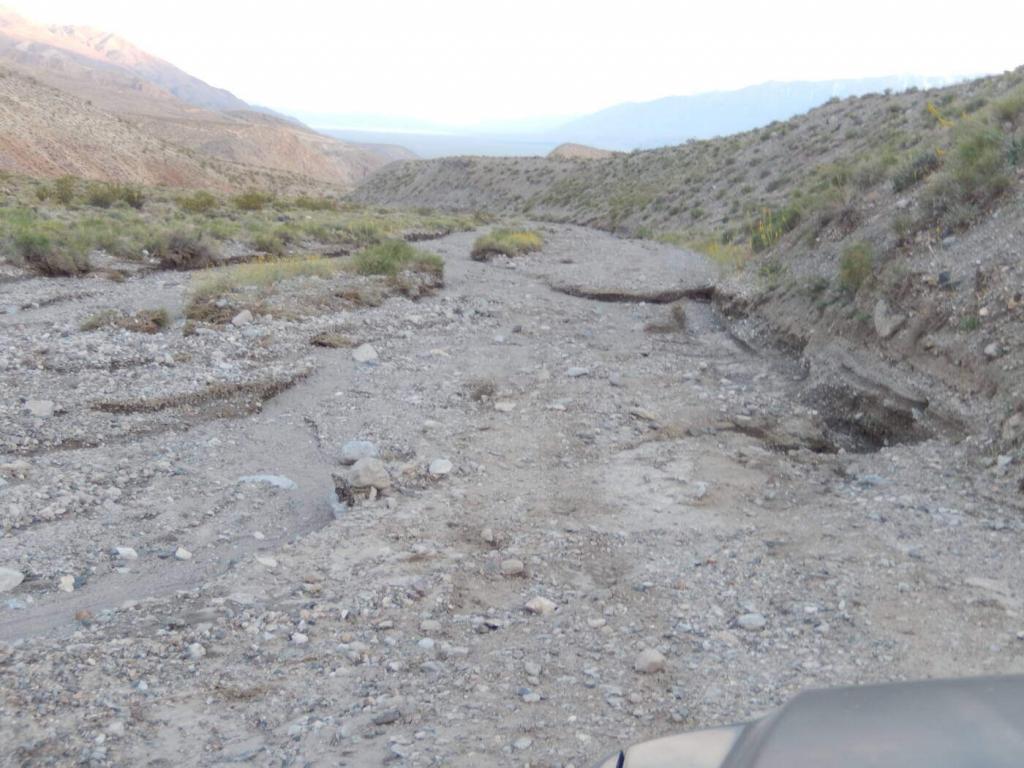
rattle and roll of the SUV. The road presented its challenges to the vehicle ground clearance and the off road tires. I kept wondering if I would be able to get down the mountain without having a flat tire, taking out the transmission or blowing a hole through the oil pan. Breaking an axle also seemed to be high on the likelihood scale. In short, it seemed that I would be very lucky to survive the trip down the mountain without having some malady occur. However, I would have my answer within the next hour as I made my way down the hill. When I was about 2/3 of the way down the hill, I encountered a group of vehicles heading up the hill. The main vehicle was a 4WD drive pickup truck towing a trailer with a 4WD quad off road vehicle. The other two vehicles were also pickup trucks of which one was a 4WD and the other was a 2WD pickup. This made it clear to me that the 2WD pickup was doomed to get stuck on the way up. However, the main vehicle was parked in the middle of the road blocking my egress thus preventing me from getting down the mountain and heading home. I sat quietly in my SUV waiting for the people to see me and move their vehicle, but they seemed to ignore my presence so I tapped the horn to alert them. I continued to sit in the SUV waiting for some response from the people who were mostly out of their vehicles and still ignoring me so eventually decided to honk the horn to get their attention. Shortly thereafter, one of the people started walking towards me so I rolled down the window to start a conversation. He stated that I was blocking them from proceeding up the mountain and that if I wanted them to clear a path for me, I would need to move over to the side of the road into a significantly worse portion of the road where the rocks would attack the undercarriage of the vehicle. I told him that he would have considerable difficulty heading up the road as there was a lot more difficult terrain ahead, but I proceeded to move my vehicle and then he started up the hill. After he went by with his vehicle and trailer, the next vehicle proceeded to pass. The third vehicle was having considerable difficulty and appeared to be stuck since it was only a 2WD vehicle. As I passed by, it told the driver that he needed to turn around and head down the hill as he would never be able to make it up the road with 2WD. I also advised him to back down out of his predicament since we did not seem to be able to pull forward. He seemed to dig a hole under his rear wheels making it impossible to get out of it heading up hill. With a little help from his passenger, he should have been able to get out of his situation while backing downhill.
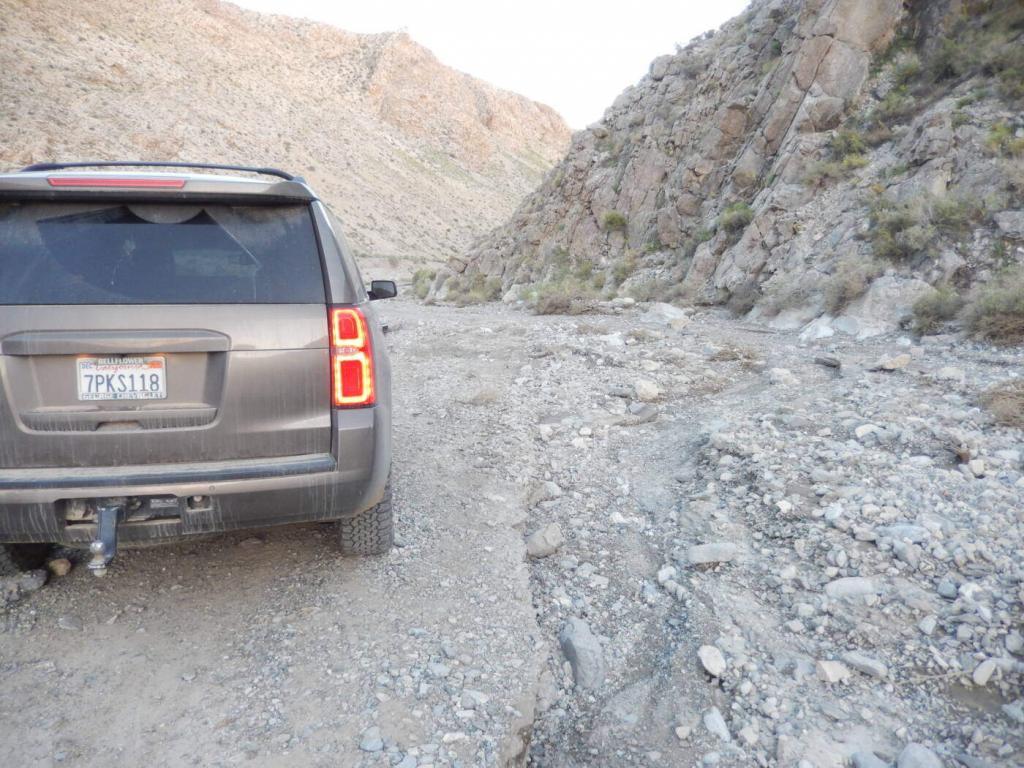
I proceeded to get back onto the better part of the road so that I could continue heading down the hill. I was crawling over the various irregularities of the roadbed which resembled a dry riverbed more than a road. The road was twisting and turning, going up and down with piles of rocks intermittently situated in just the wrong places making it difficult to navigate. I proceeded to wiggle my way down the hill avoiding the worst portions of the road while eventually getting to the end of the washed out portions of the road. The dirt roadbed now seemed to be relatively normal, eventually transitioning to a semi-paved road which allowed me to drive at a considerably higher speed. I passed the construction zone where DWP had been working on the road and now the road became fully paved, a welcome transition which allowed me to speed up to 60 mph for the balance of the trip down the mountain. Now that I was on the paved section of Mazourka Canyon Road, the ride was smooth and I could stop wondering if and when my kidneys would have to be put back into my body. With 4.5 miles to go to get back to the sheriff’s station, I would soon be able to get out of the car, stretch and walk around to work off the effects of the last two hours in the SUV.
I reached the sheriff’s station about 8:20PM. After parking the car, I went inside to use the restroom facilities and clean up. I then went into dispatch to visit with them for a few minutes and return the keys to the Mazourka building. After saying my goodbyes, I proceeded to exit the building and head south back towards Los Angeles. The drive would take about 4.5 hours to get back home, not including any time for pit stops and eating dinner so I expected to get home around 1:30AM.
The trip heading home was relatively uneventful as I drove south towards Lone Pine. Once there, I stopped at Carl’s Jr. to get something to eat. Normally, I would want to sit down to eat dinner, but it was getting late and I did not want to delay heading home any more time. This meant that dinner was ordered to go and consumed in the car as I headed south again. I kept driving while making pit stops along the road as I had consumed a considerable amount of water, Diet Coke and Diet Mountain Dew which had the amount of caffeine necessary for me to be able to continue driving at such a late hour after a long day that started at 4:30AM. I arrived in Los Angeles according to schedule and exited the freeway at Crenshaw Blvd. I headed south on Crenshaw eventually arriving at my home and parked the SUV in the driveway as predicted at 1:30AM thus making the day 21 hours from when I opened my eyes.
Another successful service call to an MRA tower site to diagnose the problem before us. Now it is time for the crew to return to the site to replace the solar panels and get the site fully operational.